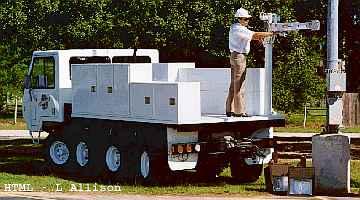Esarco see S&S Defender |
The Esarco eight wheel drive (8WD) was developed in the early 1980's by Major Michael Somerton-Rayner. The first Esarco was based on standard Land Rover 110, (later called Defender) engine, transmission and axles. The front and rear axles steer - in opposite direction - which made for a tight turning circle, a concept seen on the AEC road train as far back as the 1930's.
Two full-time four wheel drive Land Rover transfer cases were used, mounted back to back with the first driving the second through their power take-offs by a dog-clutch and a short drive shaft. The first transfer case drove axles one and three and the second transfer case drove axles two and four. The axle differentials being offset, the prop-shafts could pass neatly over the intervening axles on their way to the appropriate differentials. All in all there were six differentials - four in the axles and two in the transfer cases.
Early Esarcos used the Land Rover 3.5L V8 engine. On the road, the second transfer case was disconnected and the vehicle became an 8×4. Offroad, the second tranfer case was connected to the first, making an 8×8. The Land Rover transfer cases contained a "centre diff'" for full-time four wheel drive and were equipped with diff' locks.
Land Rover coil-spring suspension was also adopted from the Land Rover 110. A ladder-frame chassis and a simple forward-control cab structure completed the picture.
At some stage the concept was taken up by Stewart and Stevenson
of the USA, becoming the
Although intended as a "utility" 8×8, at least one Esarco was prepared for racing! In 1991 Jacob Westerfeld and Michael Amiralay prepared an Esarco for the Paris to Capetown Rally, also aiming for the Paris-Dakar Rally.
1990s: This eight wheel drive was produced as the SS300, an all terrain vehicle with 2.5 ton payload and a speed of upto 60mph.

SS300
- 1996 Stewart & Stevenson SS300 8×8, forward control truck, 2-seats, 2-doors;
- loa 5588mm (220"), width 2311mm (91"), height 2362mm (93"),
wheelbase 3302mm (130"), grnd clearance 249mm (9.8")
approach 45°, departure 50°, ramp break over excellent! (8WD!);
- weight 4036kg (8900lb) (unladen), GVM 6304kg (1390lb), payload 2268kg (5000lb);
- Cummins BT 5.9-160, 5.88L, diesel, 6-cyls, turbo-charged, power 119kW (160hp) at 2500rpm, torque 542Nm (400lb-ft) at 1700rpm;
- transmission Eaton/Fuller FS-4005a 5-spd manual, (8.05:1, 4.35:1, 2.45:1, 1.48:1, 1.00:1, rev 8.05:1), Two Fairfield 2-speed transfer cases, (hi 1.0:1, lo 2.21:1), selectable 8×4 or 8×8;
- axles Dana Model 60, track-lok LSD, ratio 3.54:1;
- suspension live-axles and coils, brakes disc;
- fuel-tank 121L (32 US gal).
- weight 4036kg (8900lb) (unladen), GVM 6304kg (1390lb), payload 2268kg (5000lb);
Back in the UK, the Esarco concept was bought by the MWG Group which refined the design but was put into administration. The 8×8 was purchased by the ex MD of MWG, Mike Hearn and a new company, H.U.G.O. (heavy use-global operation) All Terrain Vehicles Ltd. which built final prototypes and type approved the 8×8 c1991. MWG established early on that the possible users would want to carry a crew. Army gun towing, re-supply, emergency aid relief etc. - all of these usually need to carry a useful load off road and also carry the operatives. As a result MWG made the 8×8 as a diesel-engine vehicle for better fuel duration and fitted a Perkins four cylinder Phaser 110. Also fitted is an automatic Chrysler A727 gearbox and a Land Rover LT250 transfer box driving four specially made wider and stronger axles.
The body was made as a rigid frame structure and all suspension was coil with double acting shock absorbers. The cabin was constructed on a rigid square steel frame providing roll over protection. It is a four-door four-seat cab. There is room between the rear seats for a fold-down bench seat for two more or for an access door to the load deck.
- HUGO 8×8
- loa 5370mm, width 2200mm, height (cab) 2360mm
- load deck dim's 2200mm x 2770mm, top of load deck 1170mm
- Unladed 3550kg, GVW; 5550kg, Gross Train Weight 7550kg.
- track 1826mm, clearance under diff 260mm
- ramp angle 90 degrees, approach/departure angle 45 degrees.
- Engine in future 135bhp.turbo 4 cyl. diesel Torque ~ 300Nm.
- Transfer cases modified Land Rover LT 250 to suit our wheel size/ t.case ratio.
- wheels 15.5", tyres Trelleborg 305x75x16.
- load deck dim's 2200mm x 2770mm, top of load deck 1170mm
A number of a 6×6 variant were made for the Portugese Paratroops. I am told that they are still in service but we do not offer this variant now. (It tends to be a short 4×4 on heavy braking.) - Mike Hearn, HUGO ATV.
|
www #ad: |